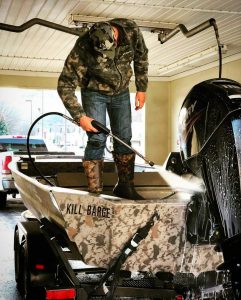During the season, we let waterfowl boat maintenance and cleaning slide a bit. We’re already getting up at 4am to beat the sun to our blind. Then, we’re hustling back to the dock because we stayed later than we meant to, and our job and/or honey-do list are waiting somewhat patiently for our return.
Once season ends, it’s finally time to get the boat straightened up. Here’s a quick checklist of tasks to do after the season closes to make sure your boat is ready for the next adventure.
Waterfowl Boat Maintenance Post Season Steps
Remove the Plug (and Store it Somewhere Safe!)
When storing your boat, you want to remove the plug to make sure it can drain completely (recommended by Field Staffer Chase Baker). Standing water inside a boat is disastrous for a number of reasons. However, there’s nothing worse than getting to the boat dock for the first time next season and realizing your plug is out! So, make sure you store the plug somewhere you’ll remember, preferably somewhere on the boat, just in case.
Remove Bolt-On Items (Pop-up Blind, Gun Racks, etc.)
You want to get a good thorough cleaning on your boat, so take everything off that you can. Remove your pop-up blind, gun racks, bolt-on storage, removable seats, etc. You’ll be amazed at the amount of muck and grass and other stuff that gets stuck under these items. If you let it sit there, it’ll just mold and hold moisture, increasing your chance for rust to form.
This is a great time to inspect all of these bolt-on accessories for your boat. Look for any cracks or points that might be wearing on the item, and make a plan to address it before next season. Make sure you store the bolts and nuts somewhere you won’t lose them!
Clean Out the Muck (and Salt Residue)
Cattails, dog hair, feathers, shotgun shells, and all manner of other hunting-related items collect in your boat during the season. Give it a thorough cleaning after the season ends. Take out the plug and spray it out with a hose or pressure washer. Use a stiff bristle broom to get rid of any caked on mud or other items that are stubborn. Give it a good detailed cleaning now before the muck goes rotten and causes other problems with your boat.
Since most of us are running around during winter months, salt from the road kicks up onto our boat and trailer. Be sure to rinse off any salt residue on the bottom side of the boat or up in the under section of your motor. Salt is especially corrosive, and can cause major issues if left sitting for extended periods of time (recommended by Field Staffer Andrew Dudek).
Maintain Your Boat’s Fuel
Modern-day fuel companies are adding ethanol to gas on a regular basis. This is fine for automobile engines but horrible for your outboard. Make sure you add a quality fuel additive to the gas tank to prevent the ethanol content from causing water to accumulate in your fuel tank. It’s also a good idea to run all the fuel out of our motor, to prevent the carburetor from getting gummed up during the offseason. If it’s going to be a while before your boat runs again, pull the fuel line and run the motor until all the fuel runs out (for outboards). This will prevent the ethanol gas from sitting in your engine and separating. (recommended by Field Staffer Andrew Dudek)
Perform Routine Engine Maintenance
You run the motor hard during the season, so make sure it’s ready for next year. Check all the hoses and connection points for any signs of a leak, crack, or weakening. Check the engine wiring for cracks in the wire shielding or loose connection points. Inspect your propeller for knicks and chips, but pay close attention to how it rotates. Make sure it spins balanced, and the shaft stays centered. Look for any signs of a bent shaft, as even a slight bend in the shaft will have a huge impact on the performance of your motor. Also check your transom mount, and make sure no bolts are coming loose anywhere on the motor. Hook it up to a garden hose and run it one last time, walking around it and looking for any potential problems before storing it for the off season. If you have a pull rope, inspect the rope for fraying. If your motor uses a battery, charge the battery and make sure it takes a full charge. Also, check the battery posts and clean any corrosion off them.
Inspect Rivets
Hitting logs and stumps can cause rivets to loosen over time, so make sure you inspect all your rivets after the season. Look for cracks in any seams or any dents or punctures that have gone unnoticed. It’s better to find them now and get them fixed than to find them the day before the opener.
Inspect Your Trailer
A reliable trailer is worth its weight in gold. Once season ends, make sure your trailer is maintained properly. Check all your trailer wiring and light bulbs. Inspect your trailer tires, and don’t forget about the trailer spare tire. Inspect the bearings as well to make sure your trailer keeps rolling next year. Work some WD-40 into the trailer hitch so it’ll be easier to hook and unhook from your truck.
Do you have something we need to add to the post season waterfowl boat maintenance checklist? Please let us know! You can contact us via the SBO Facebook page or through Instagram.
This article appears as part of our February Outdoor Checklist and our March Outdoor Checklist.
More Articles
 https://southboundoutdoors.com/wp-content/uploads/2020/03/duck-lorange-done-scaled.jpg
1920
2560
Brian Burress
https://southboundoutdoors.com/wp-content/uploads/2015/10/SBOLogoHZ_1024x1024_bd8028-300x66.png
Brian Burress2020-03-21 00:58:522020-11-18 20:40:13Duck L'Orange Recipe
https://southboundoutdoors.com/wp-content/uploads/2020/03/duck-lorange-done-scaled.jpg
1920
2560
Brian Burress
https://southboundoutdoors.com/wp-content/uploads/2015/10/SBOLogoHZ_1024x1024_bd8028-300x66.png
Brian Burress2020-03-21 00:58:522020-11-18 20:40:13Duck L'Orange Recipe https://southboundoutdoors.com/wp-content/uploads/2020/03/Roasted-Goose-Leg-scaled.jpg
1920
2560
Brian Burress
https://southboundoutdoors.com/wp-content/uploads/2015/10/SBOLogoHZ_1024x1024_bd8028-300x66.png
Brian Burress2020-03-20 18:04:142020-11-11 20:38:36Easy Roast Duck and Goose Legs
https://southboundoutdoors.com/wp-content/uploads/2020/03/Roasted-Goose-Leg-scaled.jpg
1920
2560
Brian Burress
https://southboundoutdoors.com/wp-content/uploads/2015/10/SBOLogoHZ_1024x1024_bd8028-300x66.png
Brian Burress2020-03-20 18:04:142020-11-11 20:38:36Easy Roast Duck and Goose Legs https://southboundoutdoors.com/wp-content/uploads/2018/03/IMG_4098.jpg
533
800
Brian Burress
https://southboundoutdoors.com/wp-content/uploads/2015/10/SBOLogoHZ_1024x1024_bd8028-300x66.png
Brian Burress2020-03-18 01:14:402020-03-21 00:11:22Easy Wild Game Recipes
https://southboundoutdoors.com/wp-content/uploads/2018/03/IMG_4098.jpg
533
800
Brian Burress
https://southboundoutdoors.com/wp-content/uploads/2015/10/SBOLogoHZ_1024x1024_bd8028-300x66.png
Brian Burress2020-03-18 01:14:402020-03-21 00:11:22Easy Wild Game Recipes


